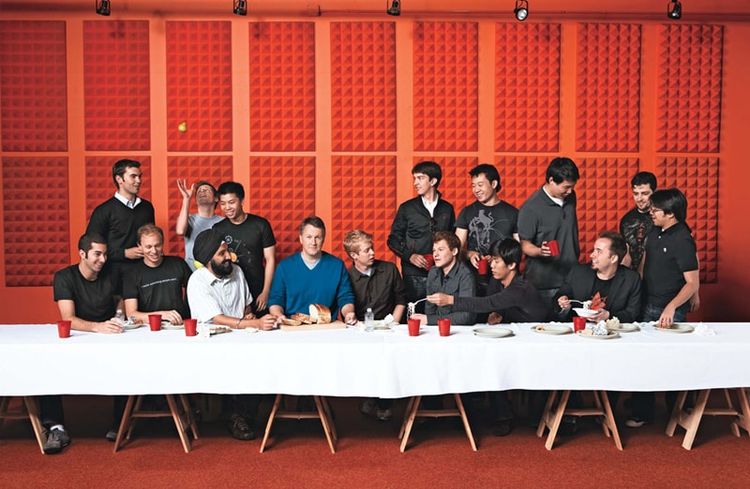The Metaverse: Is It Already Here?

When you hear a tech buzzword like “the Metaverse,” it’s easy to tune it out as just another marketing stunt, but, I think it actually represents an important vision for the future of technology. Don't get too hung up on the word “metaverse,” though, since we probably won’t be using that term for long. After all, do you know anyone who refers to the internet as “the information superhighway”?
Looking back, not all, but many of the predictions about the information superhighway were surprisingly accurate. And I think that we will eventually see the same thing with the metaverse, but the real question is "when"?
- When will VR be good enough to use for more than a few hours at a time?
- When will the average person start caring about digital goods?
- And when will computers become powerful enough to finally create a persistent virtual world?
These are tough questions, and it’s not as simple as just looking at a particular company's roadmap and estimating when they will ship a specific product. We’re talking about an era, so it’s best to think about the arrival of the metaverse in terms of a shift in behavior. Just like the internet is not a single place, but instead a collection of websites, applications, and services that work together, the metaverse just describes a collection of technologies, business models, and interactions that will look very different from today’s internet.
If we want to try and guess when the metaverse will arrive, we’ll need to pinpoint the moment at which the digital world becomes more meaningful to most people than the physical world. Artificial intelligence researchers use the concept of singularity to describe a moment when technological growth becomes uncontrollable and irreversible. Essentially, once an AI system can improve itself beyond human capabilities, these improvements will start compounding endlessly and create a superintelligence that surpasses all of humanity.
That’s still a long way off, but looking at how people interact with the digital world feels like the metaverse moment could be right around the corner. Our focus on the physical world has been declining for decades. Work has moved from conference rooms to video calls. Friendships are increasingly formed online through Twitter and Discord communities. And video games are quickly replacing sports as the dominant competitive activity.
This trend is more than just our activities, though; it’s now about identity and individualism. Many people care deeply about their online personas. Just look at any Instagram influencer, and you’ll see a perfectly curated timeline of events portraying an idealized lifestyle.
New technologies have been shifting our attention for decades now. The physical world used to be our only option, but then things started to change. TVs pulled a few hours of our attention, then computers took more, and then phones allowed us to bring the digital world with us anywhere we went.
There are currently 4.6 billion internet users globally; that’s more than half of the people on earth. We’re firmly in the internet age now, but only a small fraction of those people are fully immersed in the digital world.
A few weeks ago, a crypto-founder named Richard turned down a $9.5 million offer for his Cryptopunk NFT. Even though that is a staggering amount of money for a single profile picture, Richard said that the image was now tied to his identity and simply wasn’t for sale. This is a perfect example of someone who has already crossed over into metaverse territory.
This might sound terrible and dystopian to you, or it might sound amazing and futuristic. The good news is that you’ll have a choice. There are still 3 billion people who don’t use the internet after all, and plenty of people choose to deactivate their Facebook accounts every day. Regardless of how the idea of moving into an ever more online world makes you feel, it’s still worthwhile to try and predict when this might happen. When will we see billions of people fully immerse themselves in digital spaces?
What is the metaverse? (a definition of terms)
In order to estimate when it will be apparent that the metaverse has arrived, we have to lay some ground rules because I’ve seen a lot of heated debates on this topic.
First, we need to agree that the metaverse describes a future state and isn’t already here. I’ve seen a few people argue that Second Life or Roblox are already metaverses, and we should just stop the discussion there. It’s great to look at these two games as examples of what’s possible, but neither are fully immersive. The Metaverse will obviously build on top of what Second Life and Roblox have done, and I wouldn’t be surprised if Roblox, in particular, plays an essential role in the metaverse going forward. But it’s just not fair to say that the metaverse is already here and call it a day. After all, we had cell phones in the 1980s, but no one claims that the mobile era started then. The average person in the 80s didn’t even have a laptop, and real smartphone innovation wouldn’t pick up until the mid-2000s.
We also need to agree that the metaverse is possible and will only be successful if people actually like it. Mark Zuckerberg isn’t exactly the most popular guy in tech these days, and plenty of his detractors have said that they would never use products created by Facebook or the rebranded Meta. That’s a totally fine position to have; consumers will always have particular brand preferences; just look at all the Android versus iPhone debates. If anything, the rivalry between the two major mobile operating systems actually helped phones become ubiquitous. No one could stop talking about which phone was best, which drew a lot of attention. The metaverse will be bigger than any single company, and Zuckerberg recognizes this. We’re talking about an entirely new computing era here, not just a particular product or service.
Making the metaverse a reality will require a collection of technological advances. Virtual reality and augmented reality have to get better, systems and networks need to start talking to one another, and the internet clearly needs to get faster. But all of that is possible. We’re not talking about crazy brain computing interfaces here like Elon Musk’s Neuralink or plugging into something that perfectly recreates The Matrix. All of the ideas laid out in Ready Player One seem pretty feasible to me, even if it will take quite some time to get there. So the Oasis serves as a pretty good point of reference.
Let’s take a minute to focus on just the hardware requirements of the Metaverse. Eventually, there will be lots of different ways to interface with virtual environments, but I still think virtual reality headsets are absolutely critical here. From a casual observer’s perspective, it can look like VR development has really stalled out over the past few years. In 2012, everyone in tech was obsessed over the original Oculus Rift. Palmer Luckey was the perfect founder and quickly became the poster boy for VR, all while releasing dramatic improvements at a breakneck pace.
Fast forward to 2021, and Facebook is still releasing new versions of the Oculus, but each iteration feels more incremental. They’ve only sold a few million of them, which is nothing compared to the nearly 3 billion people who use Facebook. But it’s important to understand that Zuckerberg has a very particular strategy here. Because he’s targeting such a large audience, he isn’t working on shipping ultra-high-end headsets to the general public. But fortunately, other companies are.
The Varjo XR-3 is a great example of what’s possible in VR when money isn’t an issue. The headset costs six thousand dollars upfront and requires a fifteen hundred dollar per year subscription on top of that. It’s not made with average consumers in mind, but it’s a great demonstration of where this technology is going.
The first consumer Oculus launched in 2016 and has a resolution of a little over one megapixel per eye, which wasn’t terrible, but it led to some noticeable pixelation. The Oculus Quest 2, which came out last year, serves up about three and a half megapixels per eye, roughly equivalent to 4K, but even that isn’t enough for true immersion. The Varjo XR-3 pushes well beyond this, though, by using multiple screens stacked on top of each other to deliver more than 11 megapixels per eye. These aren’t perfect apples-to-apples comparisons since there are tons of other factors that go into making a VR experience feel truly immersive, but it’s a solid step forward. Just watch the reaction of this VR enthusiast:
This Varjo headset has lidar sensors and can be used for augmented reality as well. It also improves on field of view, which is a huge part of a good experience. The display of the second Hololens from Microsoft covers only 52 degrees, and Snap’s new AR glasses are only 26 degrees. This Varjo headset delivers 115 degrees of view, meaning you can see more of your surroundings in your peripheral vision, which is key to immersion.
Obviously, the average consumer isn’t going to spend thousands of dollars on a VR headset anytime soon, but this tech will get cheaper, and when it does, we should see adoption start to climb.
There are also a host of other technologies that need to improve before the metaverse really starts pulling people in. Even though Zuckerberg painted an incredibly optimistic picture of what this new focus might accomplish, it was John Carmack, the Chief Technology Officer of Oculus that actually had the most valuable presentation during the Meta announcement.
Even though Carmack works directly for Zuckerberg, he was very sober in his analysis:
“I have been pretty actively arguing against every single metaverse effort that we have tried to spin up internally in the company from even pre-acquisition times I am you know I want it to exist, but I have pretty good reasons to believe that go setting out to build the metaverse is not actually the best way to wind up with the metaverse.”
Here's the video for reference:
That’s an interesting perspective, especially coming from someone who’s been working at Facebook in VR for the last seven years, but it makes sense. Because the metaverse is such a broad amalgamation of technologies, it’s impossible for any single company to usher in the metaverse era alone.
But that doesn’t mean that a single company can’t have a profound impact here and make a boatload of money in the process. I believe that Zuckerberg is trying to be the next Steve Jobs, and to do it, he needs his iPhone moment.
The iPhone was a major turning point in ushering in the mobile era. There were tons of other companies that played important roles, but the iPhone really bought everything together and served as the key turning point.
And the history of Apple is really important here. In the 1980s, the Macintosh was struggling to compete with the IBM PC, so the board of directors fired Jobs. He eventually rejoined Apple in 1997 and started working on new projects. Finally, in 2007, he announced the iPhone at the end of a keynote using his now-famous “one more thing” line.
Steve Jobs: “one more thing”
I think there are a few interesting comparisons between Jobs and Zuckerberg worth discussing here. First is the redemptive story that Zuck is building around the Metaverse. He’s been the subject of intense negative attention for years now, and lots of people have been calling for him to step down. Fortunately for Zuck, he has complete control over the company and a very supportive board of directors, so I don’t think we’ll see a repeat of the Steve Jobs story play out exactly. But don’t think for a minute that Zuck doesn’t care about what people think about him. He really does want to create products that users adore. 91% of people view Apple favorably, compared to just 71% for Facebook.
And so he’s on the hunt for a big win in the metaverse. It might be VR, it might be a social platform or something else entirely, but Zuck is clearly restructuring the entire company to be able to try as many ideas as possible. I think this is a good strategy, but the messaging around Zuck’s Meta announcement could not have been more different than Jobs’ iPhone keynote, even though he borrowed the signature “one more thing”.
Mark Zuckerberg: “one more thing”
When Steve Jobs announced the iPhone, it was ready to ship. He wasn’t talking about a far-off future where mobile phones were used daily by billions of people. In fact, the first iPhone didn’t even have an app store. And Apple had been incredibly tight-lipped about the fact that they were working on a phone before the announcement. Jobs never mentioned how important mobile was going to be to Apple until they were ready to launch a polished product.
And that’s part of why it’s so hard to nail down exactly when we’ll hit the tipping point and be able to confidently say that we are in the metaverse era. There are so many different products and companies gradually improving technology and increasing immersiveness, but it might only be clear in retrospect what the key ingredients were.
Even still, I think we can make some interesting comparisons to try and project metaverse adoption.
The first is VR headsets. This year, we should see about 6 million new sales, which will bring the total number of headsets out in the world to 16 million units. That’s still incredibly low; remember, there are billions of internet users. But the growth is high at 60% per year, and if it continues, we could see one billion headsets in circulation by 2030.
You could also look at cryptocurrency adoption rates since crypto will likely play a big role in the metaverse long-term. Metamask is the fastest-growing Ethereum wallet and a critical part of the de-fi ecosystem. There are millions of people who want nothing to do with Zuckerberg’s metaverse and will only accept a decentralized option. Metamask usage is a good proxy for the size of this audience, and it’s growing even faster than VR. The wallet had half a million users in July of 2020 and just crossed 10 million users in August of 2021. That works out to an insane 20x annual growth rate, which is clearly unsustainable, but it doesn’t seem crazy to think that we could see close to a billion cryptocurrency users by the end of the decade. There are already 100 million bitcoin users, after all.
Lastly, we can look at Zuckerberg’s plan specifically. He’s aiming to deploy $180 billion over the next ten years on the initiative, so he’s obviously going to have some sort of impact. For reference, a senior Apple executive said that they spent only $150 million to develop the original iPhone. $180 billion is a staggering amount of money. Truly unprecedented in the tech industry. If Meta winds up spreading that evenly over the next ten years, they will be spending fifty times as much money as the entire Roblox team, every single year. Zuckerberg clearly thinks he can have a meaningful impact in the next ten years and has reconfigured his entire business to make something happen. We still don’t know exactly what the next decade will have in store for the metaverse, but you can be sure that some interesting things will happen here.
If you enjoyed this blog post, make sure to check out similar articles on the site. If you enjoy discussing tech, space, entrepreneurship, and much more, you should head over to our Discord Community.
This blog post is also available as a video:




